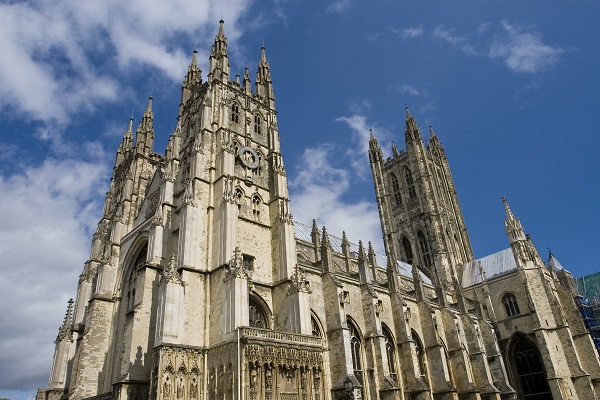14 DECEMBER 2018
An Introduction to Chaucer's Canterbury Tales

Born in the early 1340s, the only son of a well-off wine-merchant, Geoffrey Chaucer started his career as a page, and later esquire, in the royal household of King Edward III, and then served Richard II as a diplomat and courtier. We do not know anything about Chaucer’s education. In 1366 he married Philippa de Roet, a lady-in-waiting at court, and had three children: Thomas, Elizabeth, and ‘little Lewis’, for whom he wrote his only scientific work, the Treatise on the Astrolabe, in 1391. Writing poetry was not his day job. He travelled on important (often secret) diplomatic missions for the king to France, Spain, and Italy, and at various times he was controller of the customs of the Port of London, Clerk of the King’s Works, and a Justice of the Peace.
Chaucer moved in powerful political and literary circles; he was friends with several distinguished English and French poets, and in 1374 his patron John of Gaunt gave him an annuity of £10, a decent sum at the time (the cost of a good horse), presumably because he was pleased with the poem Chaucer wrote for him, The Book of the Duchess, which praises Gaunt’s dead wife Blanche. But the work that made his name during his lifetime was his romance Troilus and Criseyde. Chaucer died in 1400, and is now buried in Poets’ Corner in Westminster Abbey.
Chaucer’s most famous and memorable work, the Canterbury Tales (c.1385-1400), is a collection of 24 tales of very different types – chivalric romances, bawdy stories, saints’ lives, an animal fable, and moral tales – told by pilgrims on a road-trip from Southwark, London, to the shrine of St Thomas à Beckett at Canterbury. The tales are loosely held together by the framing-device of a storytelling competition proposed by the Host – the best story wins a free supper! – and by the social dynamic between the individual pilgrims. Having decided that the order of the tales should be determined by social rank, the Host asks the Knight to go first. He tells a ‘noble’ tale about two knights hopelessly in love with a beautiful and unattainable lady. But then the drunken, boorish Miller insists on going next, with a story of lower-class characters – a carpenter, his young wife, and her clerk-lover (and to complicate things, there’s also the clerk’s rival, a foppish parish priest). The pilgrim-Reeve, who happens to be a carpenter, is outraged by the Miller’s tale of a carpenter who is tricked, so he in turn spites the Miller by telling a tale about a corrupt miller.
Contemporary social mobility is vividly represented by this jostling for position as some of the pilgrims try to take each other down. These lively interactions give the illusion of spontaneously generating the tales and their order, as if Chaucer the author had nothing to do with it. The characters take on a life of their own. The social mobility of late medieval England is well illustrated by Chaucer’s own family: Chaucer was not an aristocrat, but his son Thomas married the daughter of an aristocrat, and Thomas’s daughter Alice became Duchess of Suffolk.
Other tales share important themes. For example, the so-called Marriage Group of tales (Wife of Bath, Clerk, Merchant, Franklin) offers different takes on husband-wife relationships, from the five-times married Wife of Bath’s rambunctious revelations of her desire to lord it over her husbands to the Clerk’s tale of Griselda, who is almost superhuman in putting up with her husband’s cruel testing of her loyalty to him. The Shipman’s Tale and Melibee are also concerned with gender politics in marriage. Another link between tales is that of religious, racial, and ethnic otherness: the Prioress’s Tale, for example, deals with Jewish-Christian relations; the Man of Law’s Tale with Muslim-Christian relations. The symbolic meaning of female virginity is another preoccupation, shared by the Prioress’s Tale, the Second Nun’s Tale, and the Physician’s Tale. All the tales are concerned with the play and variety of literary forms: with testing the boundaries and social meanings of genres through burlesque and parody (the Miller’s Tale; the Tale of Sir Thopas) or stretching a prologue (the Wife of Bath’s) into an entire text in its own right.
Chaucer’s major poem Troilus and Crisyde is one of the most poignant love stories in English literature. Set in pagan Troy, against the background of the tumultuous Trojan war, its tragic story of Criseyde’s betrayal of her faithful lover Troilus was well known to medieval audiences, but Chaucer, who is unusually sympathetic to Criseyde’s plight when the circumstances of war separate her from Troilus, transforms it into a deeply-felt exploration of the nature of human love and human failing. The seventeenth-century poet John Dryden called Chaucer the father of English poetry, but though Chaucer was much imitated by poets in the fifteenth century, he did not change the English language quite as much as he is credited with doing. Yet the fact that he wrote in English, not high-status Latin or French, and that he was considered a major poet by fifteenth-century writers was significant in helping to create a sense of prestige for the English language and an enlargement of its literary possibilities.
Ruth Evans is a Professor of English, speciaising in medieval literature and Executive Director of the New Chaucer Society.
Thank you for your feedback which will help us improve our service.
If you requested a response, we will make sure to get back to you shortly.
×